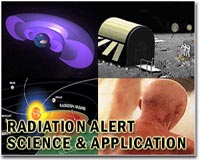 |
Paris (AFP) March 18, 2011 Scientists use different units to measure radioactivity. Some terms quantify radiation emitted, others measure radiation absorbed by human tissue, and still others the potential impact on health. RADIATION PRIMER: There are two forms oF radiation, both of which are emitted when the nucleus of an atom has too many particles, too much energy or too much mass to remain stable and thus breaks apart. Electromagnetic radiation -- which includes sunlight, x-rays and radio waves -- is pure energy with no weight. Particle radiation comprises fast-moving atomic particles that have both energy and mass. There are alpha and beta particles and neutrons. RADIATION EMITTED: In the International System of Units, or SI, the basic unit for measuring radiation given off by a radioactive source such as uranium 235, caesium 137 or iodine 131 is the becquerel, or Bq. The old unit, named after the scientist Marie Curie, is the curie (Ci). Both measures express the number of disintegrations of radioactive atoms in a radioactive material during one second: for a Bq, the ratio is one-to-one. Radioactivity levels for liquids are calculated in Bq per cubic metre, and for solids in Bq per kilo. Shortly after the 1986 Chernobyl nuclear accident, for example, atmospheric levels exceeded 100,000 Bq/m3 for cesium 137, a highly carcinogenic element. The level dropped to between 100 and 10,000 Bq/m3 in countries most directly hit by the radioactive plume thrown up by the explosion, and one to 10 Bq/m3 in western Europe. RADIATION ABSORBED: When a person is exposed to radiation, energy deposited in the body's tissue is measured per unit of body weight in an SI unit called the gray (Gy), or a conventional unit called a rad, for "radiation absorbed dose." One Gy equals 100 rad. BIOLOGICAL RISK: The risk that a person will suffer health consequences -- ranging from temporary nausea, to cancer or rapid death -- is measured in metric units by the sievert (Sv) or, more commonly, millisievert (mSv). The conventional measure, the rem, is the equivalent of 1/100th of a sievert. The level of health risk evaluated in Sv will vary depending on the type of radiation -- alpha, gamma or neutron -- and the kind of tissue exposed. Ovaries and testicles, for example, are about 20 times more sensitive to harmful radiation than skin. A chest X-ray is measured at about 0.2 mSv, and a brain scan at about 50 mSv, both thought to be negligible risks. By comparison, Japanese officials said radiation levels earlier this week were up to 400 mSv near one of the damaged reactors. During a severe nuclear accident, exposure can reach several thousand mSv near the reactor core. About half of people exposed to a 5,000 mSv dose across the entire body would probably die, while 6,000 mSv would be fatal without immediate treatment. Exposure to 10,000 mSv in a single dose would lead to death "within a few weeks," according to the World Nuclear Association (WNA), an industry group. SOURCES: US Centers for Disease Control and Prevention (CDC), French Institute for Radioprotection and Nuclear Safety (IRSN), World Nuclear Association (WNA)
Share This Article With Planet Earth
Related Links Space Technology News - Applications and Research
 Radiation levels in Japan not harmful: IAEA
Radiation levels in Japan not harmful: IAEAVienna (AFP) March 18, 2011 Radiation levels currently detected in Japan and beyond in the wake of the nuclear crisis after last week's massive earthquake do not pose any harm to human health, an IAEA expert said Friday. "Regular dose information is now being received from 47 Japanese cities," Graham Andrew, scientific and technical advisor to the head of the International Atomic Energy Agency, told a regular daily pre ... read more |
|
| The content herein, unless otherwise known to be public domain, are Copyright 1995-2010 - SpaceDaily. AFP and UPI Wire Stories are copyright Agence France-Presse and United Press International. ESA Portal Reports are copyright European Space Agency. All NASA sourced material is public domain. Additional copyrights may apply in whole or part to other bona fide parties. Advertising does not imply endorsement,agreement or approval of any opinions, statements or information provided by SpaceDaily on any Web page published or hosted by SpaceDaily. Privacy Statement |